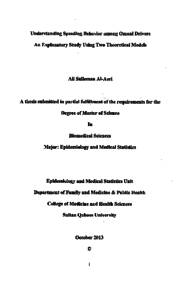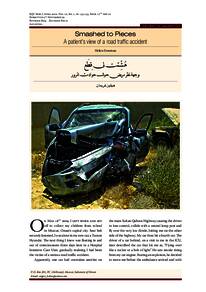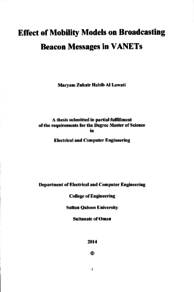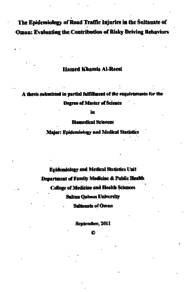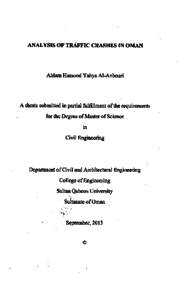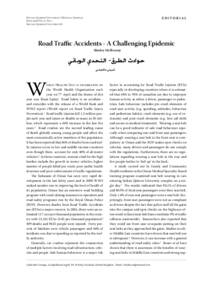Document
Understanding speeding behavior among Omani drivers : an explanatory study using two theoretical models
Publisher
Sultan Qaboos University
Gregorian
2013
Language
English
English abstract
Background: Road traffic injuries (RTIS) are the most important cause of injurious, disabilities and deaths worldwide. Deaths from RTIs account for approximately 25% of all deaths. Globally, the total number of people died from road traffic crashes (RTC) each year is estimated to be at almost 1.2 million and the number injured could reach 50 million. Oman has one of the highest Road traffic fatality (RTF) rate in the world and considered as the third highest country in the Eastern Mediterranean Region (EMR). Speeding behavior has been recognized as one of the most important risk factor in fatal RTCs and was the main cause of RTCs in the Sultanate of Oman in the year 2011. Behavioral models such as, Health Belief Model (HBM) and Theory of Planned Behavior (TPB) have been used to study speeding behavior as well as other risky driving behaviors.
Aims: The aims of this study are to identify factors that associated with speeding behavior based on Theory of Planned Behavior (TPB) and Health Belief Model (HBM) and to develop and validate a questionnaire that could be used to assess the constructs of TPB and HBM. The objectives of the study are to estimate the prevalence of speeding behavior among Omani male drivers and to find the association between speeding and socio-economic variables.
Method: A cross sectional study was conducted to understand factors influence speeding behavior among Omani drivers using theory based evidence. A total of 1800 Omani male drivers visiting directorate of vehicle registration at Royal Oman Police (ROP) were recruited to study using systematic random sampling technique. A questionnaire was developed and used to collect data concerning socio-demographic characteristics, driving behavior, driving history and the subscales of TPB and HBM. The questionnaire was assessed for validity and reliability before used to collect data.
Analysis: Descriptive and inferential statistics were used to analyze collected data. Bivariate logistic regression was used to examine the association between speeding behavior and socio-economic variables. Multivariate logistic regression was used to examine the association between speeding behavior and the constructs of TPB and HBM adjusted for confounders. Principle component analysis (PCA) with varmix rotation was used to examine the factor structure of items related to TPB and HBM.
Results: A total of 1286participants agreed to be involved in the study from a total of 1800 invited (response rate= 71.4%). There were significant associations between speeding behavior and the psychosocial characteristic of the participants (Age, driving license age, having children, monthly income, motoring and speeding offences. Having RTC has not been associated significantly with speeding behavior. Speeding behavior is significantly predicted by perceived benefits of respecting the speed limits (OR=0.94, 95%C.I: 0.91, 0.98) and barriers of respecting the speed limits (OR=1.06, 95%C.I: 1.04, 1.09). In addition, speeding behavior is significantly predicted by cues to action, attitude and subjective norms. Behavioral intention of respecting the speed limits is significantly predicting the speeding behavior (OR=0.72, 95%C.I: 0.72, 0.76). Speeding behavioral intention is significantly predicted by, attitude, subjective norms and PBC.
Conclusion: HPM and TPB could be used as a conceptual framework for an intervention programs to decrease speeding behavior among Omani male drivers; this ultimately should reduce the RTCs and RTIS.
Description
Thesis
Member of
Resource URL
Arabic abstract
ملخص الرسالة الخلفية: تعتبر إصابات حوادث الطرق من أهم أسباب الإصابات، الإعاقة و الوفيات عالمية. تمثل الوفيات الناجمة عن إصابات حوادث الطرق ما نسبته 25% من إجمالي الوفيات عالمية تقدر الوفيات الناجمة عن حوادث الطرق على مستوى العالم ب 1 2. مليون شخص سنوية بينما قد تصل الإصابات نتيجة تلك الحوادث الى 50 مليون شخص سنويا.
سلطنة عمان واحدة من إحدى الدول ذات المعدلات العالية في وفيات حوادث الطرق على مستوى العالم كما أنها تعتبر ثالث أعلى دولة على مستوى دول اقليم شرق المتوسطة السرعة واحد من أهم العوامل المؤثرة في حوادث الطرق المميتة. في سلطنة عمان تعتبر السرعة هي السبب الرئيسي لحوادث الطرق في عام 2011. تم استخدام نماذج ونظریات سلوكية كنموذج المعتقد الصحي و نظرية السلوك المخطط لدراسة سلوك السرعة وكذلك السلوكيات الخطيرة المرتبطة بالقيادة.
الأهداف: الهدف من هذه الدراسة هو التعرف على العوامل المرتبطة بسلوك السرعة لدى قائدي المركبات العمانيين باستخدام نموذج المعتقد الصحي و نظرية السلوك المخطط، بالإضافة إلى ذلك، عمل إستبيان ذات مصداقية و ثبات لقياس محاور تلك النظرية والنموذج. كذلك تهدف هذه الدراسة إلى تقدير معدل إنتشار سلوك السرعة لدى قاندي المركبات العمانيين الذكور والبحث عن إذا ما كانت هناك علاقة بين سلوك السرعة والعوامل الاجتماعية والديموغرافية
منهجية البحث: في سبيل تحقيق هدف الدراسة، تم عمل دراسة مقطعية استهدفت 1800 سائق عماني من زوار إدارة تسجيل المركبات بشرطة عمان السلطانية في ولاية السيب بمحافظة مسقط. تم تجميع أفراد العينة بإستخدام العينة العشوائية المنتظمة. تم عمل استبيان لقياس الخصائص الاجتماعية والديمغرافية، العوامل المتعلقة بتاريخ القيادة وكذلك محاور كلا من نموذج المعتقد الصحي و نظرية السلوك المخطط. تم استخدام الاستبيان بعد قياس مصداقيته وثباته. التحليل: تم إستخدام الأساليب الاحصائية الوصفية والاستنتاجية لتحليل بيانات هذه الدراسة. تم استخدام تحليل الانحدار اللوجستي ثنائي المتغيرات الدراسة العلاقة بين سلوك السرعة والعوامل الأخرى. بالإضافة إلى ذلك تم إستخدام تحليل الانحدار اللوجستي متعدد المتغيرات لدراسة العلاقة بين سلوك السرعة ومحاور كلا من نموذج المعتقد الصحي و نظرية السلوك المخطط كما تم إستخدام تحليل المكون الرئيسي لقياس مصداقية الاستبيان النتائج: معدل الإستجابة للدراسة هو 71%توجد علاقة ذات دلالة إحصائية بين سلوك السرعة و كلا من المتغيرات التالية: العمر، عمر رخصة القيادة الدخل الشهري، المخالفات المرورية. لا توجد علاقة ذات دلالة إحصائية بين سلوك السرعة لدى السائق وارتكابة لحوادث طرق سابقا. من ضمن المحاور الخمسة في نموذج المعتقد . الصحي وجد أن محور إدراك الفوائد من الإلتزام بالسرعة المحددة يمكنه التنبؤ بسلوك السرعة (نسبة الأرجحية = 0 . 94، % 95 مدى الثقة: 0 . 91 , 0 . 98 ). بالإضافة إلى ذلك المحور، يمكن التنبؤ بسلوك السرعة عن طريق محور
إدراك العقبات إتجاه الإلتزام بالسرعة المحددة (نسبة الأرجحية = 1 . 06، 95% مدى الثقة: 1 . 09 1 . 04 ). كذلك وجد أن محور المعتقدات السلوكية ، المعتقدات المعيارية والنية وراء السلوك (محاور نظرية السلوك المخطط) يمكنها
التنبؤ بسلوك السرعة لدي قائدي المركبات العمانيين. الخلاصة: يمكن إستخدام نموذج المعتقد الصحي و نظرية السلوك المخطط كإطار مفاهيمي لبرامج التدخل والتي تهدف إلى خفض سلوك السرعة لدي قائدي المركبات العمانيين والذي بدوره يؤدي إلى خفض حوادث الطرق والإصابات الناجمة من تلك الحوادث
سلطنة عمان واحدة من إحدى الدول ذات المعدلات العالية في وفيات حوادث الطرق على مستوى العالم كما أنها تعتبر ثالث أعلى دولة على مستوى دول اقليم شرق المتوسطة السرعة واحد من أهم العوامل المؤثرة في حوادث الطرق المميتة. في سلطنة عمان تعتبر السرعة هي السبب الرئيسي لحوادث الطرق في عام 2011. تم استخدام نماذج ونظریات سلوكية كنموذج المعتقد الصحي و نظرية السلوك المخطط لدراسة سلوك السرعة وكذلك السلوكيات الخطيرة المرتبطة بالقيادة.
الأهداف: الهدف من هذه الدراسة هو التعرف على العوامل المرتبطة بسلوك السرعة لدى قائدي المركبات العمانيين باستخدام نموذج المعتقد الصحي و نظرية السلوك المخطط، بالإضافة إلى ذلك، عمل إستبيان ذات مصداقية و ثبات لقياس محاور تلك النظرية والنموذج. كذلك تهدف هذه الدراسة إلى تقدير معدل إنتشار سلوك السرعة لدى قاندي المركبات العمانيين الذكور والبحث عن إذا ما كانت هناك علاقة بين سلوك السرعة والعوامل الاجتماعية والديموغرافية
منهجية البحث: في سبيل تحقيق هدف الدراسة، تم عمل دراسة مقطعية استهدفت 1800 سائق عماني من زوار إدارة تسجيل المركبات بشرطة عمان السلطانية في ولاية السيب بمحافظة مسقط. تم تجميع أفراد العينة بإستخدام العينة العشوائية المنتظمة. تم عمل استبيان لقياس الخصائص الاجتماعية والديمغرافية، العوامل المتعلقة بتاريخ القيادة وكذلك محاور كلا من نموذج المعتقد الصحي و نظرية السلوك المخطط. تم استخدام الاستبيان بعد قياس مصداقيته وثباته. التحليل: تم إستخدام الأساليب الاحصائية الوصفية والاستنتاجية لتحليل بيانات هذه الدراسة. تم استخدام تحليل الانحدار اللوجستي ثنائي المتغيرات الدراسة العلاقة بين سلوك السرعة والعوامل الأخرى. بالإضافة إلى ذلك تم إستخدام تحليل الانحدار اللوجستي متعدد المتغيرات لدراسة العلاقة بين سلوك السرعة ومحاور كلا من نموذج المعتقد الصحي و نظرية السلوك المخطط كما تم إستخدام تحليل المكون الرئيسي لقياس مصداقية الاستبيان النتائج: معدل الإستجابة للدراسة هو 71%توجد علاقة ذات دلالة إحصائية بين سلوك السرعة و كلا من المتغيرات التالية: العمر، عمر رخصة القيادة الدخل الشهري، المخالفات المرورية. لا توجد علاقة ذات دلالة إحصائية بين سلوك السرعة لدى السائق وارتكابة لحوادث طرق سابقا. من ضمن المحاور الخمسة في نموذج المعتقد . الصحي وجد أن محور إدراك الفوائد من الإلتزام بالسرعة المحددة يمكنه التنبؤ بسلوك السرعة (نسبة الأرجحية = 0 . 94، % 95 مدى الثقة: 0 . 91 , 0 . 98 ). بالإضافة إلى ذلك المحور، يمكن التنبؤ بسلوك السرعة عن طريق محور
إدراك العقبات إتجاه الإلتزام بالسرعة المحددة (نسبة الأرجحية = 1 . 06، 95% مدى الثقة: 1 . 09 1 . 04 ). كذلك وجد أن محور المعتقدات السلوكية ، المعتقدات المعيارية والنية وراء السلوك (محاور نظرية السلوك المخطط) يمكنها
التنبؤ بسلوك السرعة لدي قائدي المركبات العمانيين. الخلاصة: يمكن إستخدام نموذج المعتقد الصحي و نظرية السلوك المخطط كإطار مفاهيمي لبرامج التدخل والتي تهدف إلى خفض سلوك السرعة لدي قائدي المركبات العمانيين والذي بدوره يؤدي إلى خفض حوادث الطرق والإصابات الناجمة من تلك الحوادث
Category
Theses and Dissertations

